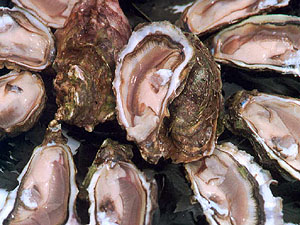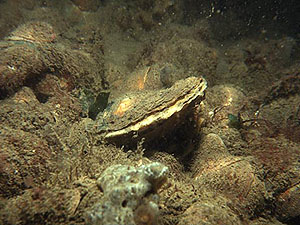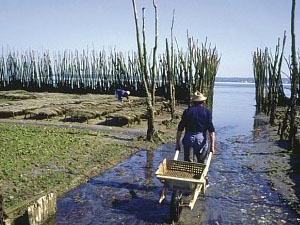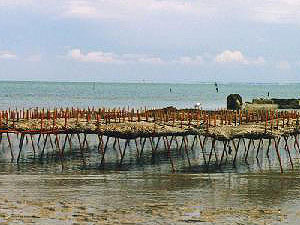
 |
Besides their healthy effect, oysters are well esteemed as a delicacy for the rich and beautiful.
A European oyster produces
between 600,000 and 3 million eggs per year.
For some weeks the larvae swim
the sea together with other plankton. From the fertilised egg hatches a larva
that is called a trochophora, because it bears an equatorial ciliar belt
and a terminal ciliar crest. After the first metamorphosis the trochophora transforms
into a larval stage, that possesses two ciliated sail-like protrusions and thus
is called veliger (sail bearer). As well as the trochophora the veliger
is a planktontic larval stage. After a further metamorphosis the veliger changes
into a bivalve small juvenile oyster. That clings on a suitable rock with its
byssus threads and sticks its shell to he rock with a self produced cement.
In their further life the oyster will not leave its place any more.![]() Development of the European oyster.
Development of the European oyster.

Picture: Peter Dyrynda.
Oysters feed by filtering plankton out of their breathing water. Thus however they accumulate many harmful agents out of the sea water. For instance heavy metals that are dumped into the sea by seaside industry plants can be accumulated by oysters.
 Source: "Le jardinier de la mer". |
|
Especially copper and zinc are among such heavy metals - up to 20,000 ppm (parts per million) copper and up to 60,000 pp zinc. The accumulation of copper in oysters does not mean any danger for humans, but the oysters can change their smell and taste and can even change their colour to an unpleasant green.
A greater danger probably arises from contamination by micro organisms. As oysters are consumed raw, micro organisms are not killed, as they would be, had the oysters been grilled or cooked. Thus one may be in danger of catching fatal bacterial infections by eating raw oysters.
 Source: Ostréiculture à Cancale. |
As sea fruit ("fruits de mer") oysters have become a valuable mussel for man. Natural oyster beds have become rare due to excessive fishing and illnesses. After the cold winter of 1920/21 live European oysters were rarely to be found. In the 1980s on cultivation areas near Sylt in the North Sea another species, the Pacific Oyster (Crassostrea gigantea) have been introduced that proved to grow and to distribute faster. Partly they also even displaced the European oyster by growing over the native oysters' beds.
Oysters are not only food but like many mussel species they repel parasites and other foreign objects by surrounding them with a layer of mother-of-pearl. That is the innermost layer of the mussel shell. Mother-of-pearl is secreted by glands in the mantle's outer tissue layers. The oyster defends itself against an intruder and produces - a pearl.
Pearl producing oysters are cultivated by man, because such mussels have become very rare in nature. In Japan, for example, pearl producing oysters are cultivated on aquacultures like edible mussels. Artificially grains of sand are implanted, which the oyster coats in nacre, so they change into pearls. The pearl then can later be harvested without the oyster having to be killed.